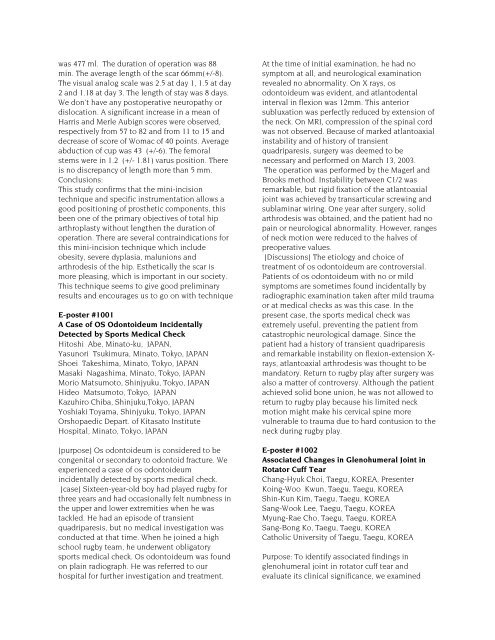POSTER ABSTRACTS - ISAKOS
POSTER ABSTRACTS - ISAKOS
POSTER ABSTRACTS - ISAKOS
You also want an ePaper? Increase the reach of your titles
YUMPU automatically turns print PDFs into web optimized ePapers that Google loves.
was 477 ml. The duration of operation was 88<br />
min. The average length of the scar 66mm(+/-8).<br />
The visual analog scale was 2.5 at day 1, 1.5 at day<br />
2 and 1.18 at day 3. The length of stay was 8 days.<br />
We don’t have any postoperative neuropathy or<br />
dislocation. A significant increase in a mean of<br />
Harris and Merle Aubign scores were observed,<br />
respectively from 57 to 82 and from 11 to 15 and<br />
decrease of score of Womac of 40 points. Average<br />
abduction of cup was 43 (+/-6). The femoral<br />
stems were in 1.2 (+/- 1.81) varus position. There<br />
is no discrepancy of length more than 5 mm.<br />
Conclusions:<br />
This study confirms that the mini-incision<br />
technique and specific instrumentation allows a<br />
good positioning of prosthetic components, this<br />
been one of the primary objectives of total hip<br />
arthroplasty without lengthen the duration of<br />
operation. There are several contraindications for<br />
this mini-incision technique which include<br />
obesity, severe dyplasia, malunions and<br />
arthrodesis of the hip. Esthetically the scar is<br />
more pleasing, which is important in our society.<br />
This technique seems to give good preliminary<br />
results and encourages us to go on with technique<br />
E-poster #1001<br />
A Case of OS Odontoideum Incidentally<br />
Detected by Sports Medical Check<br />
Hitoshi Abe, Minato-ku, JAPAN,<br />
Yasunori Tsukimura, Minato, Tokyo, JAPAN<br />
Shoei Takeshima, Minato, Tokyo, JAPAN<br />
Masaki Nagashima, Minato, Tokyo, JAPAN<br />
Morio Matsumoto, Shinjyuku, Tokyo, JAPAN<br />
Hideo Matsumoto, Tokyo, JAPAN<br />
Kazuhiro Chiba, Shinjuku,Tokyo, JAPAN<br />
Yoshiaki Toyama, Shinjyuku, Tokyo, JAPAN<br />
Orshopaedic Depart. of Kitasato Institute<br />
Hospital, Minato, Tokyo, JAPAN<br />
[purpose] Os odontoideum is considered to be<br />
congenital or secondary to odontoid fracture. We<br />
experienced a case of os odontoideum<br />
incidentally detected by sports medical check.<br />
[case] Sixteen-year-old boy had played rugby for<br />
three years and had occasionally felt numbness in<br />
the upper and lower extremities when he was<br />
tackled. He had an episode of transient<br />
quadriparesis, but no medical investigation was<br />
conducted at that time. When he joined a high<br />
school rugby team, he underwent obligatory<br />
sports medical check. Os odontoideum was found<br />
on plain radiograph. He was referred to our<br />
hospital for further investigation and treatment.<br />
At the time of initial examination, he had no<br />
symptom at all, and neurological examination<br />
revealed no abnormality. On X rays, os<br />
odontoideum was evident, and atlantodental<br />
interval in flexion was 12mm. This anterior<br />
subluxation was perfectly reduced by extension of<br />
the neck. On MRI, compression of the spinal cord<br />
was not observed. Because of marked atlantoaxial<br />
instability and of history of transient<br />
quadriparesis, surgery was deemed to be<br />
necessary and performed on March 13, 2003.<br />
The operation was performed by the Magerl and<br />
Brooks method. Instability between C1/2 was<br />
remarkable, but rigid fixation of the atlantoaxial<br />
joint was achieved by transarticular screwing and<br />
sublaminar wiring. One year after surgery, solid<br />
arthrodesis was obtained, and the patient had no<br />
pain or neurological abnormality. However, ranges<br />
of neck motion were reduced to the halves of<br />
preoperative values.<br />
[Discussions] The etiology and choice of<br />
treatment of os odontoideum are controversial.<br />
Patients of os odontoideum with no or mild<br />
symptoms are sometimes found incidentally by<br />
radiographic examination taken after mild trauma<br />
or at medical checks as was this case. In the<br />
present case, the sports medical check was<br />
extremely useful, preventing the patient from<br />
catastrophic neurological damage. Since the<br />
patient had a history of transient quadriparesis<br />
and remarkable instability on flexion-extension X-<br />
rays, atlantoaxial arthrodesis was thought to be<br />
mandatory. Return to rugby play after surgery was<br />
also a matter of controversy. Although the patient<br />
achieved solid bone union, he was not allowed to<br />
return to rugby play because his limited neck<br />
motion might make his cervical spine more<br />
vulnerable to trauma due to hard contusion to the<br />
neck during rugby play.<br />
E-poster #1002<br />
Associated Changes in Glenohumeral Joint in<br />
Rotator Cuff Tear<br />
Chang-Hyuk Choi, Taegu, KOREA, Presenter<br />
Koing-Woo Kwun, Taegu, Taegu, KOREA<br />
Shin-Kun Kim, Taegu, Taegu, KOREA<br />
Sang-Wook Lee, Taegu, Taegu, KOREA<br />
Myung-Rae Cho, Taegu, Taegu, KOREA<br />
Sang-Bong Ko, Taegu, Taegu, KOREA<br />
Catholic University of Taegu, Taegu, KOREA<br />
Purpose: To identify associated findings in<br />
glenohumeral joint in rotator cuff tear and<br />
evaluate its clinical significance, we examined
















